Green Biosynthesis of Silver Nanoparticles Using Callicarpa maingayi Stem Bark Extraction
Abstract
:1. Introduction
2. Results and Discussion
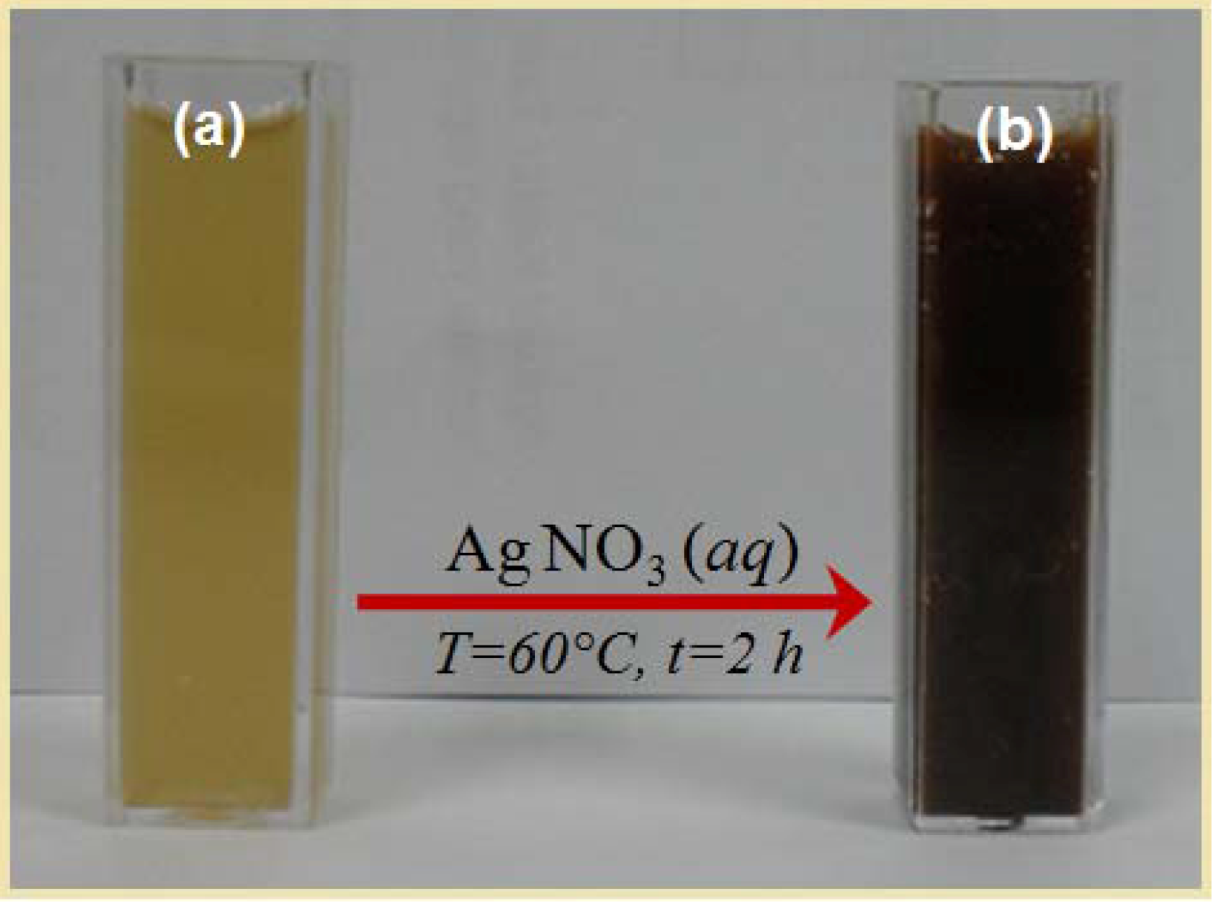


2.1. UV-Visible Spectroscopy Analysis
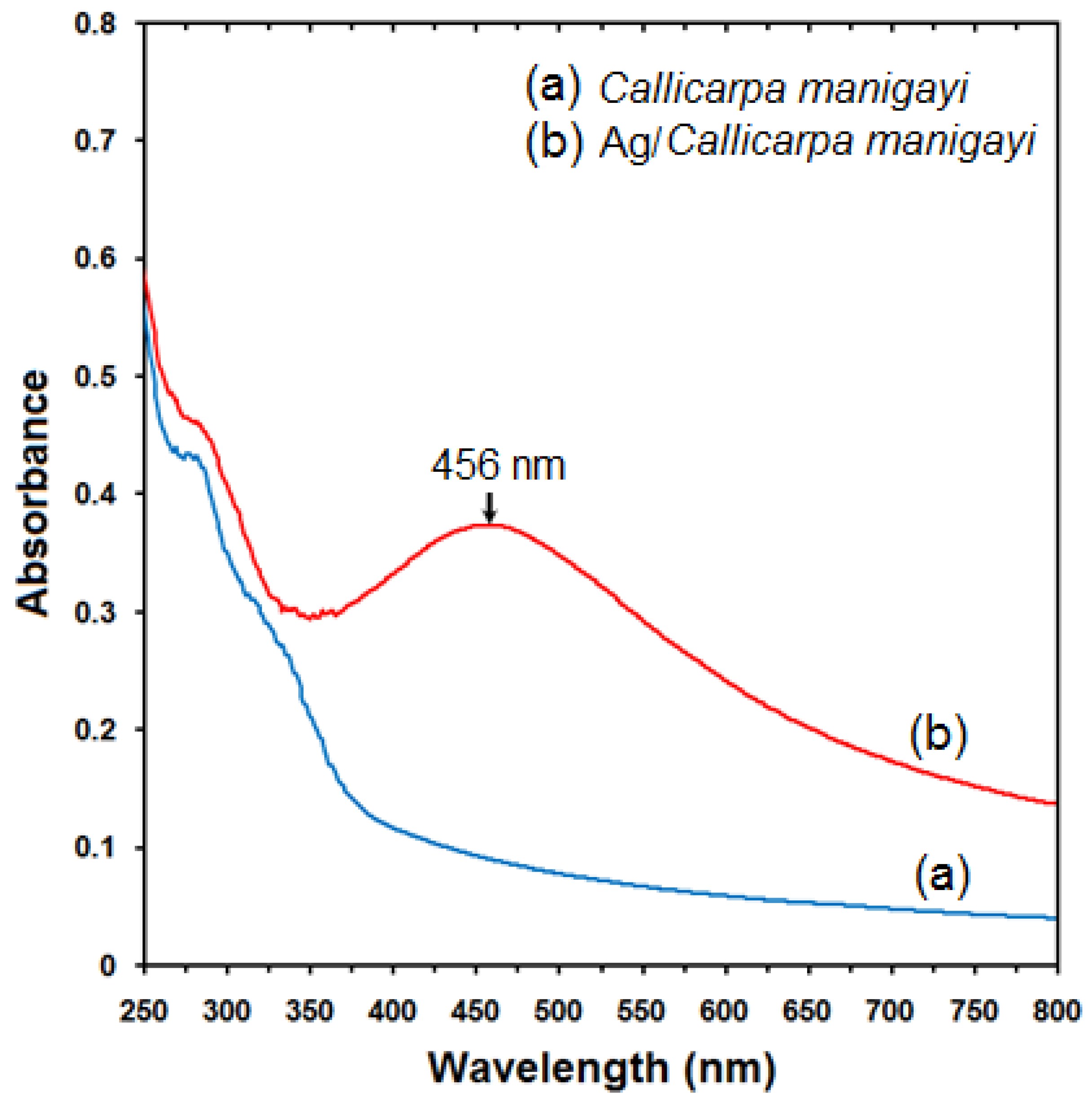
2.2. Powder X-ray Diffraction
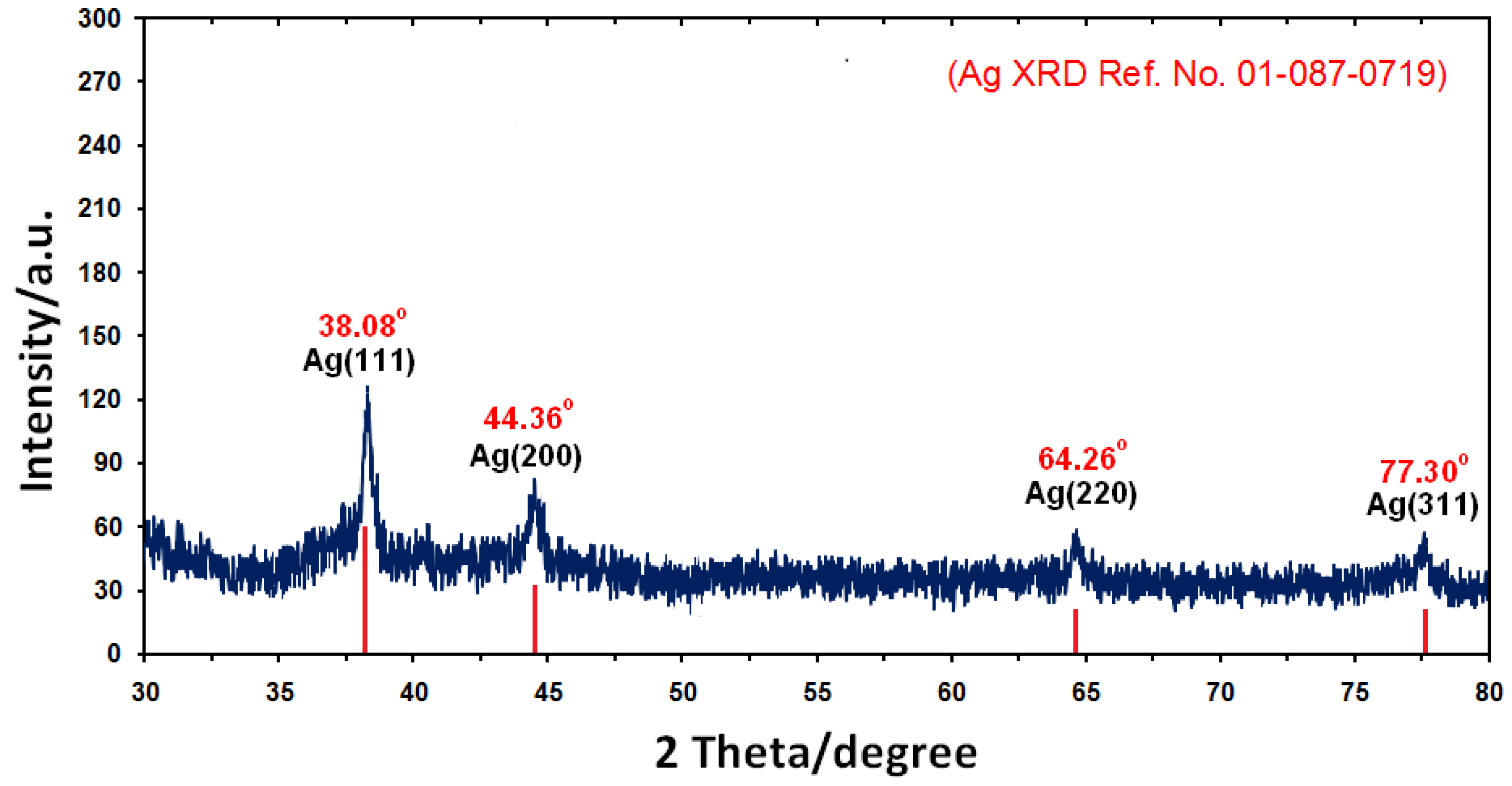

2.3. Morphology Study
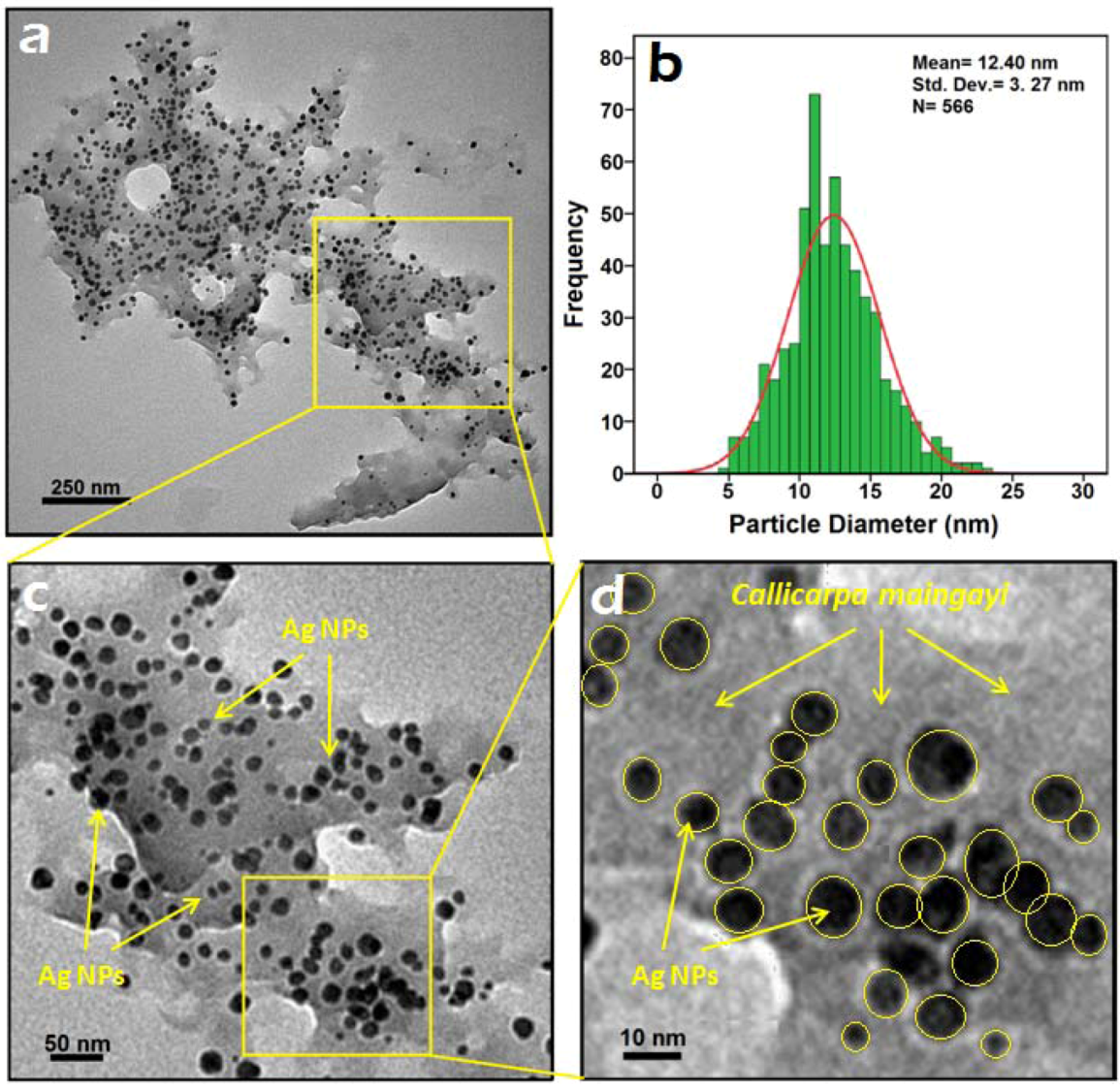
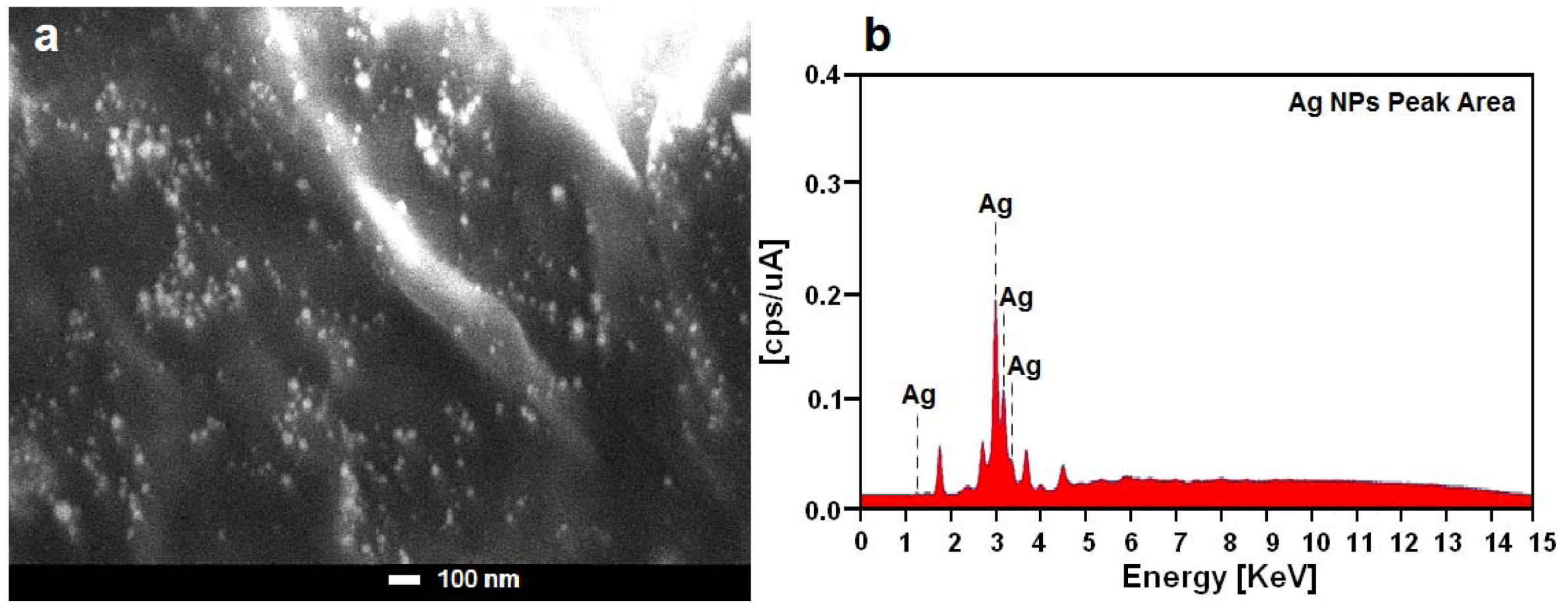
2.4. FT-IR Chemical Analysis
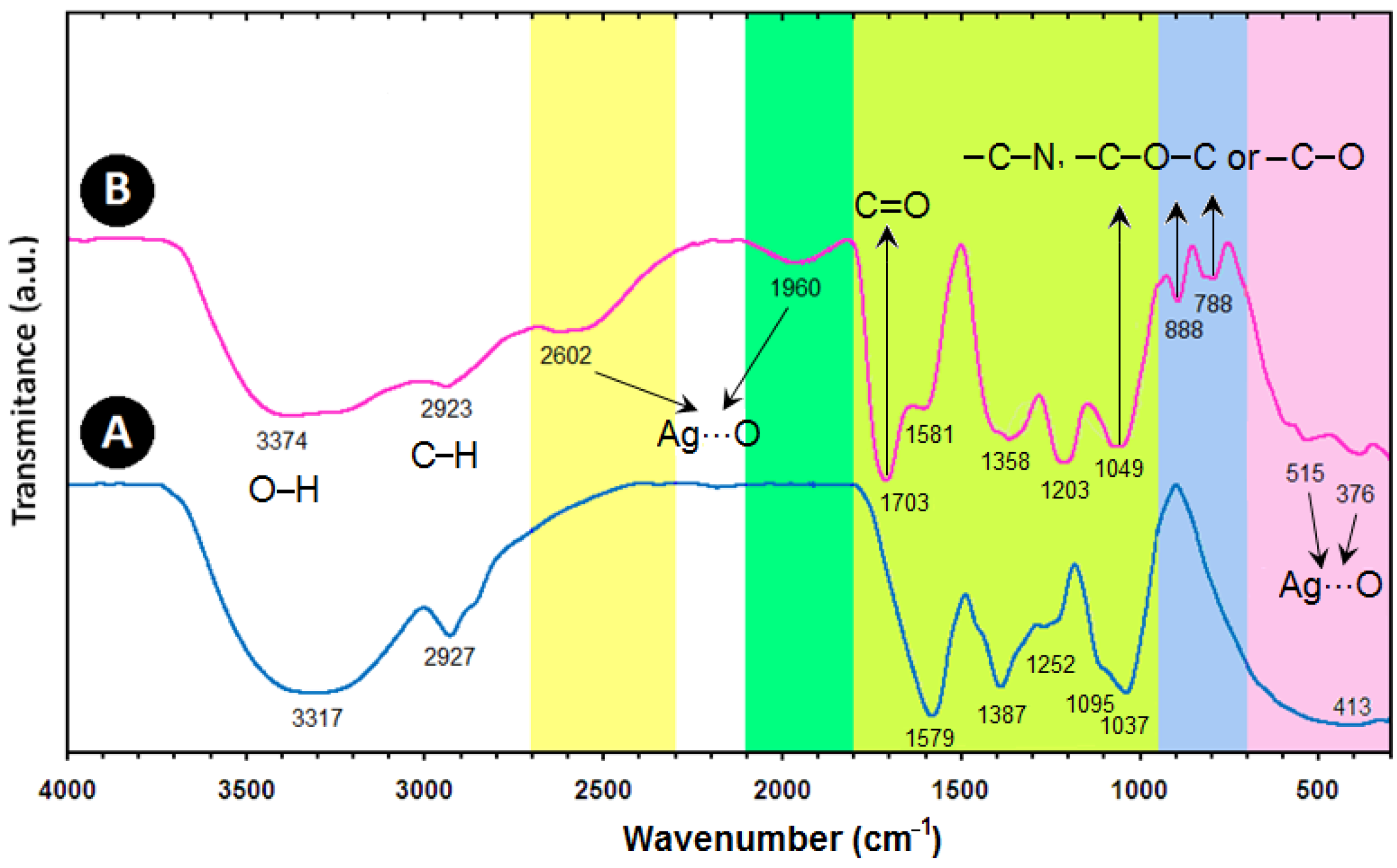
2.5. Zeta Potential Measurement
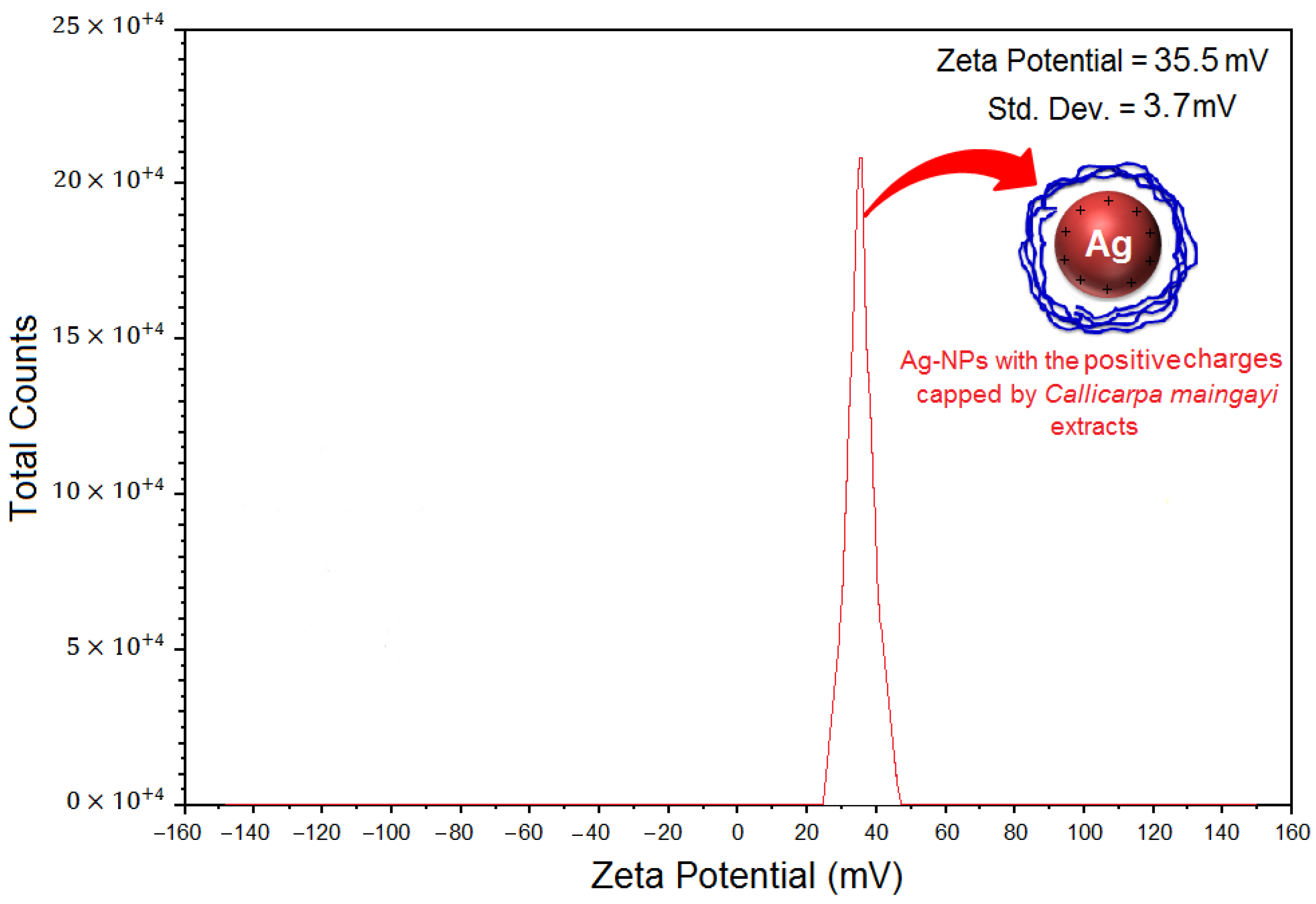
3. Experimental
3.1. Materials and Method
3.2. Extraction Preparation
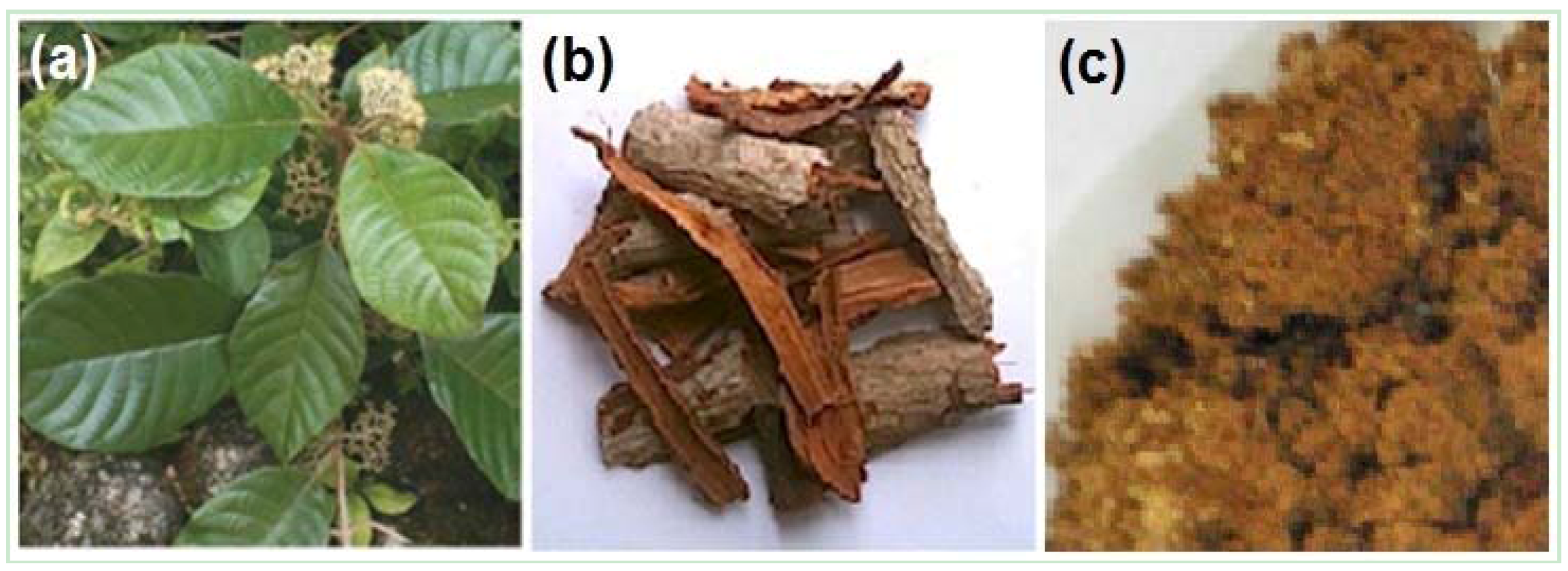
3.3. Synthesis of Ag/Callicarpa maingayi Emulsion
3.4. Characterization Methods and Instruments
4. Conclusions
Acknowledgments
References
- Gurunathan, S.; Kalishwaralal, K.; Vaidyanathan, R.; Deepak, V.; Pandian, S.R.K.; Muniyandi, J. Biosynthesis, purification and characterization of silver nanoparticles using Escherichia coli. Colloid. Surf. B 2009, 74, 328–335. [Google Scholar] [CrossRef]
- Ankanna, S.; Prasad, T.N.V.K.V.; Elumalai, E.K.; Savithramma, N. Production of biogenic silver nanoparticles using Boswellia Ov Alifoliolata stem bark. Dig. J. Nanomater. Bios. 2010, 5, 369–372. [Google Scholar]
- Rai, M.; Yadav, A.; Gade, A. Silver nanoparticles as a new generation of antimicrobials. Biotechnol. Adv. 2009, 27, 76–83. [Google Scholar] [CrossRef]
- Shameli, K.; Ahmad, M.B.; Wan Yunus, W.M.Z.; Ibrahim, N.A.; Gharayebi, Y.; Sedaghat, S. Synthesis of silver/montmorillonite nanocomposites using γ-irradiation. Int. J. Nanomed. 2010, 5, 1067–1077. [Google Scholar]
- Shameli, K.; Ahmad, M.B.; Wan Yunus, W.M.Z.; Rustaiyan, A.; Ibrahim, N.A.; Zargar, M.; Abdollahi, Y. Green synthesis of silver/montmorillonite/chitosan bionanocomposites using the UV-irradiation method and evaluation of antibacterial activity. Int. J. Nanomed. 2010, 5, 875–887. [Google Scholar]
- Zhang, Y.; Chen, F.; Zhuang, J. Synthesis of silver nanoparticles via electrochemical reduction on compact zeolite film modified electrodes. Chem. Commun. 2002, 2814–2815. [Google Scholar]
- Szczepanowicz, K.; Stefańska, J.; Socha, R.P. Preparation of silver nanoparticles via chemical reduction and their antimicrobial activity. Physicochem. Probl. Miner. Process. 2010, 45, 85–98. [Google Scholar]
- Shameli, K.; Ahmad, M.B.; Zargar, M.; Wan Yunus, W.M.Z.; Rustaiyan, A.; Ibrahim, N.A. Synthesis of silver nanoparticles in montmorillonite and their antibacterial behavior. Int. J. Nanomed. 2010, 6, 581–590. [Google Scholar]
- Shameli, K.; Ahmad, M.B.; Wan Yunus, W.M.Z.; Ibrahim, N.A. Synthesis and characterization of silver/talc nanocomposites using the wet chemical reduction method. Int. J. Nanomed. 2010, 5, 743–751. [Google Scholar]
- Shameli, K.; Ahmad, M.B.; Zargar, M.; Wan Yunus, W.M.Z.; Ibrahim, N.A. Fabrication of silver nanoparticles doped in the zeolite framework and antibacterial activity. Int. J. Nanomed. 2011, 6, 331–341. [Google Scholar]
- Shameli, K.; Ahmad, M.B.; Jazayeri, S.D.; Sedaghat, S.; Shabanzadeh, P.; Jahangirian, H.; Mahdavi, M.; Abdollahi, Y. Synthesis and characterization of polyethylene glycol mediated silver nanoparticles by the green method. Int. J. Mol. Sci. 2012, 13, 6639–6650. [Google Scholar] [CrossRef]
- Pastoriza Santos, I.; Liz Marzán, L.M. Formation and stabilization of silver nanoparticles through reduction by N,N-dimethylformamide. Langmuir 1999, 15, 948–951. [Google Scholar] [CrossRef]
- Ahmad, M.B.; Shameli, K.; Wan Yunus, W.M.Z.; Ibrahim, N.A. Synthesis and characterization of silver/clay/starch bionanocomposites by green method. Aust. J. Basic Appl. Sci. 2010, 4, 2158–2165. [Google Scholar]
- Setua, P.; Pramanik, R.; Sarkar, S. Synthesis of silver nanoparticle inside the nonaqueous ethylene glycol reverse micelle and a comparative study to show the effect of the nanoparticle on the reverse micellar aggregates through solvation dynamics and rotational relaxation measurements. J. Phys. Chem. B 2010, 114, 7557–7564. [Google Scholar]
- Praus, P.; Turicová, M.; Klementová, M. Preparation of silver-montmorillonite nanocomposites by reduction with formaldehyde and borohydride. J. Braz. Chem. Soc. 2009, 20, 1351–1357. [Google Scholar] [Green Version]
- Sun, L.; Zhang, Z.; Dang, H. A novel method for preparation of silver nanoparticles. Mater. Lett. 2003, 57, 3874–3879. [Google Scholar] [CrossRef]
- Raveendran, P.; Fu, J.; Wallen, S.L. Completely “green” synthesis and stabilization of metal nanoparticles. J. Am. Chem. Soc. 2003, 125, 13940–13941. [Google Scholar] [CrossRef]
- Sathishkumar, M.; Sneha, K.; Won, S.W.; Cho, C.W.; Kim, S.; Yun, Y.S. Cinnamon zeylanicum bark extract and powder mediated green synthesis of nano-crystalline silver particles and its bactericidal activity. Colloid. Surf. B 2009, 73, 332–338. [Google Scholar] [CrossRef]
- Rai, A.; Singh, A.; Ahmad, A.; Sastry, M. Role of halide ions and temperature on the morphology of biologically synthesized gold nanotriangles. Langmuir 2006, 22, 736–741. [Google Scholar]
- Gardea Torresdey, J.L.; Parsons, J.G.; Dokken, K.; Peralta Videa, J.R.; Troiani, H.; Santiago, P.; Jose Yacaman, M. Formation and growth of Au nanoparticles inside live alfalfa plants. Nano Lett. 2002, 2, 397–401. [Google Scholar]
- Gardea Torresdey, J.L.; Gomez, E.; Peralta Videa, J.R.; Parsons, J.G.; Troiani, H.; Jose Yacaman, M. Alfalfa sprouts: A natural source for the synthesis of silver nanoparticles. Langmuir 2003, 19, 1357–1361. [Google Scholar] [CrossRef]
- Shankar, S.S.; Rai, A.; Ankamwar, B.; Singh, A.; Ahmad, A.; Sastry, M. Biological synthesis of triangular gold nanoprisms. Nat. Mater. 2004, 3, 482–488. [Google Scholar]
- Zargar, M.; Hamid, A.A.; Bakar, F.A.; Shamsudin, M.N.; Shameli, K.; Jahanshiri, F.; Farahani, F. Green synthesis and antibacterial effect of silver nanoparticles using Vitex Negundo L. Molecules 2011, 16, 6667–6676. [Google Scholar]
- Kelly, K.L.; Coronado, E.; Zhao, L.L.; Schatz, G.C. The optical properties of metal nanoparticles: The influence of size, shape and dielectric environment. J. Phys. Chem. B 2003, 107, 668–677. [Google Scholar]
- Stepanov, A.L. Optical Properties of Metal nanoparticles synthesized in a polymer by ion implantation: A review. Tech. Phys. 1997, 49, 143–153. [Google Scholar] [CrossRef]
- Stamplecoskie, K.G.; Scaiano, J.C. Light emitting diode can control the morphology and optical properties of silver nanoparticles. J. Am. Chem. Soc. 2010, 132, 1825–1827. [Google Scholar] [CrossRef]
- Ahmad, M.B.; Tay, M.Y.; Shameli, K.; Hussein, M.Z.; Lim, J.J. Green synthesis and characterization of silver/chitosan/polyethylene glycol nanocomposites without any reducing agent. Int. J. Mol. Sci. 2011, 12, 4872–4884. [Google Scholar] [CrossRef]
- Ahmad, M.B.; Lim, J.J.; Shameli, K.; Ibrahim, N.A.; Tay, M.Y. Synthesis of silver nanoparticles in chitosan, gelatin and chitosan/gelatin bionanocomposites by a chemical reducing agent and their characterization. Molecules 2011, 16, 7237–7248. [Google Scholar]
- Shameli, K.; Ahmad, M.B.; Zargar, M.; Wan Yunus, W.M.Z.; Ibrahim, N.A.; Shabanzadeh, P.; Ghaffari-Moghadam, M. Synthesis and characterization of silver/montmorillonite/chitosan bionanocomposites by chemical reduction method and their antibacterial activity. Int. J. Nanomed. 2011, 6, 271–284. [Google Scholar] [CrossRef]
- Huang, J.; Li, Q.; Sun, D.; Lu, Y.; Su, Y.; Yang, X.; Wang, H.; Wang, Y.; Shao, W.; He, N.; Hong, J.; Chen, C. Biosynthesis of silver and gold nanoparticles by novel sundried Cinnamomum camphora leaf. Nanotechnology 2007, 18, 1–11. [Google Scholar]
- Luo, L.; Yu, S.; Qian, S.; Zhou, T. Large-scale fabrication of flexible silver/cross-linked poly (vinyl alcohol) coaxial nanoscale by a facial solution approach. J. Am. Chem. Soc. 2005, 127, 2822–2823. [Google Scholar]
- Jacobs, C.; Müller, R.H. Production and characterization of a budesonide nanosuspension for pulmonary administration. Pharm. Res. 2002, 19, 189–194. [Google Scholar] [CrossRef]
- Sample Availability: Samples of the different experiments are available from the authors.
© 2012 by the authors; licensee MDPI, Basel, Switzerland. This article is an open-access article distributed under the terms and conditions of the Creative Commons Attribution license (http://creativecommons.org/licenses/by/3.0/).
Share and Cite
Shameli, K.; Bin Ahmad, M.; Jaffar Al-Mulla, E.A.; Ibrahim, N.A.; Shabanzadeh, P.; Rustaiyan, A.; Abdollahi, Y.; Bagheri, S.; Abdolmohammadi, S.; Usman, M.S.; et al. Green Biosynthesis of Silver Nanoparticles Using Callicarpa maingayi Stem Bark Extraction. Molecules 2012, 17, 8506-8517. https://doi.org/10.3390/molecules17078506
Shameli K, Bin Ahmad M, Jaffar Al-Mulla EA, Ibrahim NA, Shabanzadeh P, Rustaiyan A, Abdollahi Y, Bagheri S, Abdolmohammadi S, Usman MS, et al. Green Biosynthesis of Silver Nanoparticles Using Callicarpa maingayi Stem Bark Extraction. Molecules. 2012; 17(7):8506-8517. https://doi.org/10.3390/molecules17078506
Chicago/Turabian StyleShameli, Kamyar, Mansor Bin Ahmad, Emad A. Jaffar Al-Mulla, Nor Azowa Ibrahim, Parvaneh Shabanzadeh, Abdolhossein Rustaiyan, Yadollah Abdollahi, Samira Bagheri, Sanaz Abdolmohammadi, Muhammad Sani Usman, and et al. 2012. "Green Biosynthesis of Silver Nanoparticles Using Callicarpa maingayi Stem Bark Extraction" Molecules 17, no. 7: 8506-8517. https://doi.org/10.3390/molecules17078506
APA StyleShameli, K., Bin Ahmad, M., Jaffar Al-Mulla, E. A., Ibrahim, N. A., Shabanzadeh, P., Rustaiyan, A., Abdollahi, Y., Bagheri, S., Abdolmohammadi, S., Usman, M. S., & Zidan, M. (2012). Green Biosynthesis of Silver Nanoparticles Using Callicarpa maingayi Stem Bark Extraction. Molecules, 17(7), 8506-8517. https://doi.org/10.3390/molecules17078506



